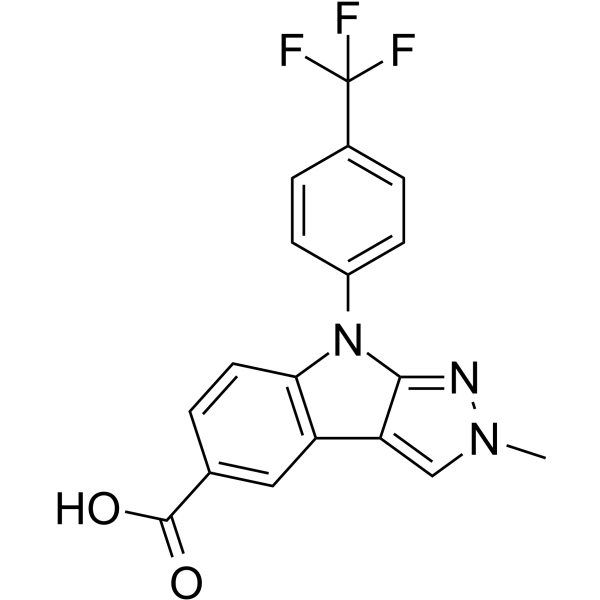| In Vitro |
MSC-4106 (10 μM, 24 h) inhibited SK-HEP-1 reporter and NCI-266 cell viability with IC50 values of 4 nM and 14 nM, respectively[1]. MSC-4106 (10 μM, 6 h) crystallizes in the P-site of TEAD1, and against TEAD1 or TEAD3 palmitoylation in TEAD-Overexpressing HEK293 Cells by 97.3% and 75.9%, respectively[1]. MSC-4106 (10 μM, 4 d) targets TEAD indicated by a reduction in viability of NCI-H226 cells[1]. Cell Viability Assay[1] Cell Line: NCI-H226 (YAP dependent); SW620 YAP/TAZ KO (Yap-independent) cells Concentration: 0, 3, 6, 9, 12, 15, 18, 21, 24, 26, 30 μM Incubation Time: 96 hours Result: Showed inhibitory effect to NCI-H226 and general cytotoxic to SW620 (IC50 >30 μM). Immunofluorescence[1] Cell Line: SK-HEP-1 Concentration: 0, 3, 6, 9, 12, 15, 18, 21, 24, 26, 30 μM Incubation Time: 24 hours Result: Inhibited YAP-TEAD interation.
|
| In Vivo |
MSC-4106 (P.O.; 100 mg/kg once daily; 7 days) displays anti-tumor effect with controlled tumor volume and good tolerability with stable body weight in mice[1]. MSC-4106 (P.O.; 1, 5, 100 mg/kg once daily; 6, 24, 30, 48, and 72 h) down-regulates Cyr61 (cysteine-rich angiogenic inducer 61) expression, the TEAD-regulated target gene, in tumor lysates at all time points at 100 mg/kg and 24 h at 5 mg/kg[1]. Pharmacokinetics (PK) profile in different species[1] Parameter Mouse Rat Dog Cl (l/h/kg) 0.2 0.7 0.05 PO t1/2 (h) 45 40 3.6 PO AUC (μg•h/mL) 45 10 33 Vss (L/kg) 2 5 0.3 F (%) >90 80 18Note: PO studies were performed at 10 mg/kg; MSC-4106 was formulated in 20% Kleptose in 50 mM PBS at pH 7.4. Animal Model: NCI-H226 xenograft model in H2d Rag2 female mice (9-week-old)[1] Dosage: 5, 100 mg/kg Administration: Oral gavage; once daily; 32 days Result: Resulted tumor growth controlled with 5 mg/kg while regressed with 100 mg/kg dosing after 32 treatment days.
|
